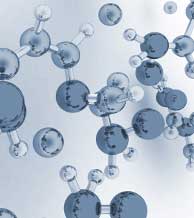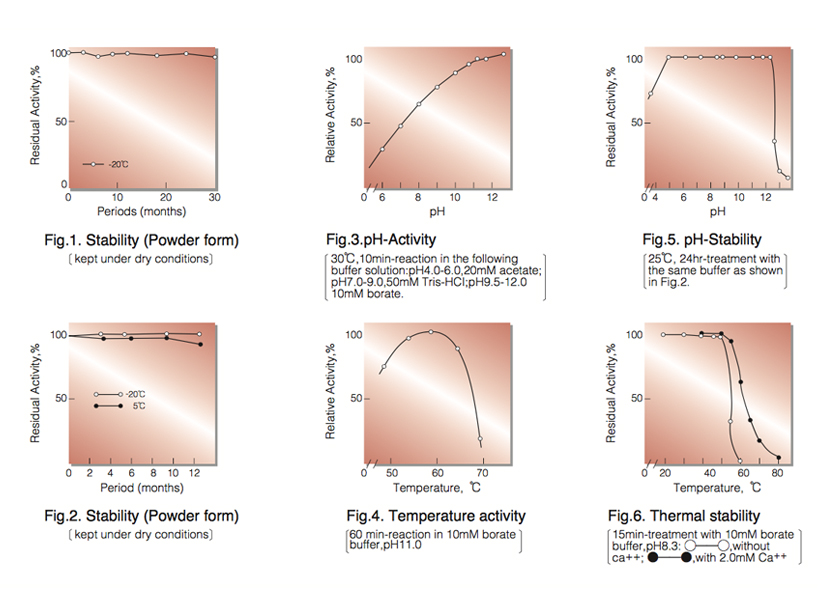ALKALOPHILIC PROTEINASE from Streptomyces sp.
Alkaline protease (EC 3. 4. 21. −)

| Appearance: | White amorphous powder, lyophilized | |
|---|---|---|
| Activity: | Grade Ⅰ 20U/mg-solid or more | |
| Stabilizer: | Ca⁺⁺ | |
| Stability: | Stable at −20ºC for at least one year(Fig.1) |
|---|---|
| Molecular weight: | approx. 50,000 |
| Isoelectric point: | 8.7 |
| Inhibitors: | Diisopropyl fluorophosphate, EDTA |
| Optimum pH : | |
| Optimum temperature: | 60℃(Fig.3) |
| pH Stability: | pH 5.0-11.5 (25°C,24hr)(Fig.4) |
| Thermal stability: | below 50℃ (pH 8.3, 15min) (Fig.5) |
APPLICATIONS¹· ²⁾
This enzyme is more active at a higher pH range than the known alkaline protease, showing the
proteolytic activity even in 0.2N NaOH solution. This enzyme is useful for proteolysis of insoluble protein
and for structure investigation of protein.
ALP-101
ASSAY
Principle:

The appearance of peptides is measured as tyrosine equivalent at 275nm by spectrophotomertry.
Unit definition:
One unit causes the increase of optical density at 275nm corresponding to one micromoloe of tyrosine per minute under the conditions described below.
Method:
| A.Casein solution: | 0.6% [Suspend 3.0g of Hammersten milk casein (ICN Biomedicals) in 20ml to 0.1N NaOH solution and dissolve by warming in a hot water bath (60℃). Cool down to room temperature, add 50ml of 0.1M borax and 400ml of H₂O and, after adjusting the pH to 11.0 with 1.0N NaOH solution, fill up to 500ml with H₂O] (Stable for one week if stored at 0−5℃) |
|---|---|
| B. TCA mixture: | 0.11M Trichloroacetic acid (TCA) containing 0.22M sodium acetate and 0.33M acetic acid |
| C. Enzyme diluent: | 2.0mM calcium acetate |
Procedure
| Concentration in assay mixture | |
|---|---|
| Borax | 8.6 mM |
| Casein | 5.1mg/ml |
| Ca(CH₃COO)₂ | 0.29 mM |
1. Pipette 3.0ml of substrate solution (A) into a test tube and
equilibrate at 30℃ for about 5minutes.
2. Add 0.5ml of the enzyme solution* and mix.
3. After exactly 10 minutes at 30℃, add 3.2ml of TCA mixture (B) to stop the reaction.
4. Incubate for further 20 minutes at 30℃.
5. Filter the mixture with a filter paper and measure the optical density of the filtrate at
275nm (OD test).
At the same time, prepare the blank by first mixing the substrate solution with 3.2ml of TCA mixture (B)
after 10 min-incubation at 30℃, followed by addition of the enzyme solution, and carry out the same
procedure (procedure 4−5) at test (OD blank).
* Dissolve the enzyme preparation in ice-cold 10mM borax-NaOH buffer, pH 11.0 and dilute to 0.1−0.4U/ml
with enzyme diluent (C), immediately before assay.
Calculation
Activity can be calculated by using the following formula :

ΔOD (OD test−OD blank) × Vt × df
Volume activity (U/ml) = =ΔOD× df
1.34 × 1.0 ×t × Vs
Weight activity (U/mg) = (U/ml) × 1/C
- Vt
- : Total volume (6.7ml)
- Vs
- : Sample volume (0.5ml)
- 1.34
- : Millimolar extinction coefficient of tyrosine (㎠/micromole)
- 1.0
- : Light path length (cm)
- t
- : Reaction time (10 minutes)
- df
- : Dilution factor
- C
- : Enzyme concentration in dissolution (c mg/ml)
REFERENCES
- T.Nakanishi, Y.Matsumura, N.Minamiura and T.Yamamoto; Agric. Biol. Chem., 38, 37 (1974).
- T.Nakanishi and T.Yamamoto; Agric. Biol. Chem., 38, 2391 (1974).
- B.Hagihara, H.Matsubara, M.Nakai and K.Okunuki; J.Biol.Chem., 45, 185 (1958).

To get a quote, contact us at info@toyobousa.com, or INQUIRY.